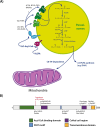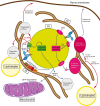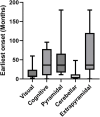The neurological pathology of peroxisomal ACBD5 deficiency - lessons from patients and mouse models
- PMID: 40672445
- PMCID: PMC12263615
- DOI: 10.3389/fnmol.2025.1602343
The neurological pathology of peroxisomal ACBD5 deficiency - lessons from patients and mouse models
Abstract
The absence or dysfunction of the peroxisomal membrane protein Acyl-CoA Binding Domain-Containing Protein 5 (ACBD5) is the cause of the most recently discovered peroxisomal disorder "Retinal Dystrophy with Leukodystrophy" (RDLKD). ACBD5 is a tail-anchored protein, anchored by its C-terminus into the peroxisomal membrane; hence, the bulk of its amino acid sequence faces the cytosol. With respect to ACBD5's molecular functions, RDLKD is unique since it is not only an accessory protein for the import of very-long-chain fatty acids (VLCFAs) into peroxisomes but also the first identified peroxisomal tethering protein facilitating membrane contacts with the endoplasmic reticulum (ER). Consequently, RDLKD is neither a peroxisomal biogenesis disorder nor single enzyme deficiency, since a deficiency in ACBD5 likely affects several aspects of peroxisomal function including VLCFA degradation, ether lipid synthesis, docosahexaenoic acid synthesis but also the transfer of membrane lipids from the ER to peroxisomes. Hence, RDLKD appears to be a multifactorial disorder leading to a mosaic pathology, combining symptoms caused by the disruption of several pathways. In this review, we will highlight recent findings obtained from case reports of RDLKD patients as well as insights from ACBD5-deficient mouse models to better understand its complex retinal and brain pathology. Moreover, we will discuss the possible contribution of the different dysregulated metabolites in the neurological pathogenesis of this latest peroxisomal disorder.
Keywords: ACBD5; RDLKD; VAP; fatty acid metabolism; membrane contact sites; peroxisomes.
Copyright © 2025 Dawes, Haberlander, Islinger and Schrader.
Conflict of interest statement
The authors declare that the research was conducted in the absence of any commercial or financial relationships that could be construed as a potential conflict of interest.
Figures




Similar articles
-
Deficiency of a Retinal Dystrophy Protein, Acyl-CoA Binding Domain-containing 5 (ACBD5), Impairs Peroxisomal β-Oxidation of Very-long-chain Fatty Acids.J Biol Chem. 2017 Jan 13;292(2):691-705. doi: 10.1074/jbc.M116.760090. Epub 2016 Nov 29. J Biol Chem. 2017. PMID: 27899449 Free PMC article.
-
Zinc oxide nanoparticles disrupt peroxisome-endoplasmic reticulum contacts and increase very-long-chain fatty acid content.J Biol Chem. 2025 Jul 16;301(8):110488. doi: 10.1016/j.jbc.2025.110488. Online ahead of print. J Biol Chem. 2025. PMID: 40680838
-
Short-Term Memory Impairment.2024 Jun 8. In: StatPearls [Internet]. Treasure Island (FL): StatPearls Publishing; 2025 Jan–. 2024 Jun 8. In: StatPearls [Internet]. Treasure Island (FL): StatPearls Publishing; 2025 Jan–. PMID: 31424720 Free Books & Documents.
-
The Black Book of Psychotropic Dosing and Monitoring.Psychopharmacol Bull. 2024 Jul 8;54(3):8-59. Psychopharmacol Bull. 2024. PMID: 38993656 Free PMC article. Review.
-
Signs and symptoms to determine if a patient presenting in primary care or hospital outpatient settings has COVID-19.Cochrane Database Syst Rev. 2022 May 20;5(5):CD013665. doi: 10.1002/14651858.CD013665.pub3. Cochrane Database Syst Rev. 2022. PMID: 35593186 Free PMC article.
References
-
- Al Shamsi B., Ganesh A., Harikrishna B., Al Zuhaibi S., Markovic I., Mansy A., et al. (2025). Retinal dystrophy and leukodystrophy caused by ACBD5 deficiency in five Omani patients: A case series. Oman. Med. J. 39. 10.5001/omj.2025.34 - DOI
Publication types
LinkOut - more resources
Full Text Sources

